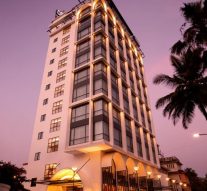Goa is abuzz with excitement as vintage bike and car owners, users, collectors and fans are decking […]

Rane lifted all curbs on bldgs, FAR Zoomed Up at Zero Cost!
Cover Story September 26, 2025By Praveena Sharma
Real estate players made a windfall by availing unlimited and free extra floor area ratio (FAR) following amendment and corrigendum inserted in Goa Land Development and Building Construction Regulation, 2010, by the TCP Minister Vishwajit Rane and his officials in 2023
Over a month after the Town and Country Planning (TCP) Minister Vishwajit Rane – in a bid to course correct – notified an order to levy Rs1,000 on additional FAR or height for construction projects, a criminal complaint has been lodged against him and two TCP officials in the Panaji police station.
The complaint was registered on September 8 by activists Swapnesh Sherlekar, Pravinsingh Shedgainkar and Rupesh Shinkre.
It accuses the minister, former chief town planner (Planning) Rajesh Naik – suspended on the last day of his retirement on April 30 last year – and current chief town planner (Planning and Administration) Vertika Dagur of causing loss to the government exchequer for “monetary benefits to hoteliers/applicants/businessmen/real estate developers and builders”.
As per the Comptroller and Audit General (CAG) report, brought out early this year, waiver of fee by TCP department for additional FAR to 321 projects as per fees structure of the finance department resulted in loss of Rs107.36 crore to the State and Rs2147.12 crore if fees structure of the TCP department is taken into consideration.
The complainants allege the officers caused the loss by not “prescribing any fee for grant of additional FAR and height” given to commercial projects.
Activist Sherlekar said they could not register an FIR and would soon be approaching the court for their complaint to be “taken in the form of an FIR”.
“We want our complaint to be taken in the form of an FIR so that there is a thorough police investigation into the case,” said Sherlekar.
The complaint stated the accused carried out their actions with “dishonest intension” as they were well aware of the government notification on the fee to be charged for extra FAR.
They were referring to the notification issued by TCP department in 2015, which grants four-star and five-star hotels “an additional FAR of 20% on the recommendation of the committee and on the approval of the government, but on payment of Rs20,000 per sqm”.
Apparently, in the amended regulation 6.1.1 of the Goa Land Development and Building Construction Regulation, 2010, notified by the TCP officers, allegedly on recommendation of Rane on August 9, 2023, a new clause 2 was inserted for further raising the FAR and height granted by authorities.
In less than two weeks after the amended regulation was notified, the ceiling on FAR and height for construction projects was completely removed through an “illegally” issued corrigendum on August 21, 2023.
The corrigendum is claimed to be illegal by the complainants because it was not decided in the steering committee meeting, chaired by Chief Minister Pramod Sawant, on July 7, 2023 to “promulgate notification” on higher FAR and height to commercial projects.
“The decision to issue corrigendum (on August 21, 2023) was not made in said steering committee meeting and was on the instruction of the accused persons,” notes the complaint.
This meeting was also attended by Rane, Naik and Dagur as “invitee, member secretary and member”. According to the complaint, there was also no decision taken “to allow free of cost additional FAR and height to project proponents”.
“The common object of accused persons was to cause huge monetary loss to the government and to cause equivalent benefit to private businesses/project proponents,” states the complaint.
When the regulatory lapse came to the notice of the government, the finance department, with the consent of the CM, issued a letter to Naik to retrospectively levy Rs1,000 per sqm for additional FAR and height on approved projects proposals.
“I’m directed to inform you that henceforth all proposals which are granted additional FAR and height shall be charged an additional amount of Rs1,000 per sqm of additional built-up area proposed by the builder due to upward revision from the prescribed FAR and height,” states the letter written by Pranab G Bhat of Goa’s finance department the TCP department’s chief on September 30, 2024.
This instruction was dismissed by accused saying its was “not possible to respectively recover fees from the applicants/builders”.
The complaint further states the accused continued “approving addition height and FAR free of cost thus incurring additional losses to the state exchequer, which could have been averted”.
According to the complaint, the law department of Goa had advised that “a belated stand of the accused officers to levy fee at Rs1,000 per sqm by an order was not on sound footing and directed the accused officers to amend the Note (2) of Clause (a) of said regulation 6.1.1 to specify such fees”.
Last month, Rane notified prescribed levy on additional FAR retrospectively following a massive outcry over the flagrant breach of TCP fees rules and regulations.
This order notifies a fee for higher FAR will be recovered retrospectively from projects approved in the past. The notified levy will apply “with retrospective effect from August 9, 2023,” the date when the amendment of the Goa Land Development and Building Construction Regulation, 2010 was officially notified.
The fee will also be applied prospectively for project approved in future.
A leading town planner, who did not want to be named, told Goan Observer Rane’s belated action is “too little too late”.
“It’s too little too late. It seemed very strange that before it (additional FAR) was free and then suddenly it’s being charged. Yet, they charge Rs 20,000 per sqm for increase in the FAR to hotels. There seems to be a disparity between what they are charging for extra FAR to hotels and to houses,” he averred.
The planner believes the principle of increasing FAR, irrespective of whether it is free or paid, goes against the basic principle of town planning, which is supposed to be universal and benefits all.
Talking on paid additional FAR, he said it creates “distorted development”, where only people who can pay get to build extra while others are left out.
According to him, close to 900 alterations in FAR across Goa may have been carried out over the last few years. He insisted any increase in the FAR should be done on the basis of the carrying capacity of an area.
Carrying capacity of a village, a town or a locality can be estimated taking into consideration resources such as water, power, food production, quality of air, civic infrastructure and amenities and other such aspects.
The urban planner said the Regional Plan, 2021 has a sound strategy for the State’s development.
“The Regional Plan, 2021, has made adequate provisions (for Goa’s development). Even though its manifesto was set in 2021, its perspective can definitely last up to 2040 with the sort of land that’s available for building on,” he said.
The planner sees the development currently taking place in Goa as “speculative”; “It’s (Goa’s real estate development) like a stock market. It’s clearly not benefitting Goa. It’s just for money making because most people building here are not going to stay here. They will sell it to somebody else, who will also probably not stay here”.
He advocated for multiple tax slabs – tied to the price of property – and tax on second homes to check speculative growth in Goa’s real estate sector.
“There should be policies for tax on second homes. UK has a very high tax on second homes. They (UK) have double taxation based on the size and locality of your house. These sorts of strategies will definitely help in curbing speculative development,” he quipped.
These measures can be adopted to ensure sustainable development in Goa. A lot of damage – both financial and ecological – has already been done.
Now that Rane has caved in, it has to be seen whether his move will help recover the revenue loss to the State or whether it’s lost forever in the blackhole of exchequer loss.
In the past, authorities have hardly ever been able to make good the State losses. One of the glaring examples is the massive Rs35,000-crore loss (between 2005 and 2012) to the government exchequer due to illegal mining.















